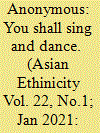| Srl | Item |
| 1 |
ID:
186912


|
|
|
|
|
| Summary/Abstract |
Despite the impressive research of scholars on Middle Persian grammatical problems, there are still many words in surviving texts that are shrouded in ambiguity. One of these words, whose pronunciation in the inscriptions we owe to the Manichaean texts, is dastan. In this article, first the few available instances of this word in Middle Persian inscriptions and Manichaean texts are mentioned, and scholars’ interpretations of its meaning and grammatical category are discussed. Then it is revisited through the analysis of another word, tuwān, with which it is paired in the Manichaean instance. After a review of prior scholarly interpretations of this latter word, it is argued that in Middle Persian tuwān is a noun, and that it became a modal verb during the process of its application to the possessive structure. Finally, it is asserted that dastan also is a noun, due to its conjoinment with tuwān in the Manichaean example.
|
|
|
|
|
|
|
|
|
|
|
|
|
|
|
|
| 2 |
ID:
177585


|
|
|
|
|
| Summary/Abstract |
This article examines the politics of China’s Intangible Cultural Heritage (ICH) policy and practice in Xinjiang through a study of the profound transformation of three interlinked Uyghur oral traditions ostensibly safeguarded as UNESCO or national-level cultural heritages: muqam, mäshräp and dastan. Based on fieldwork in Xinjiang and among the Uyghur diaspora, it shows how an intensive process of social reengineering, taking place in the nexus of contested state ICH policies and its ‘War on Terror,’ has transformed complex religio-cultural traditions into simplified and exoticized patriotic ‘song and dance’ performances. While the state defines these staged versions as ‘authentic’ heritage that should not be deviated from, community elders and cultural practitioners see them as ‘fake’; they violate community values and disembed fluid oral traditions from everyday life, which is where they are reproduced and generationally transmitted. The rhetoric of ‘safeguarding’ thus represents a disavowal of its actual effects and the severe restrictions on spaces available for cultural practice in Xinjiang.
|
|
|
|
|
|
|
|
|
|
|
|
|
|
|
|